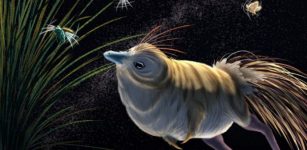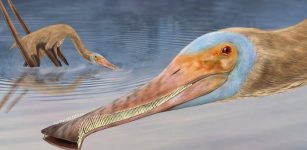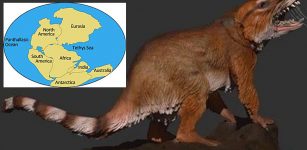Giant Prehistoric Flying Reptile Took Off Like Bats – Study
Eddie Gonzales Jr. – MessageToEagle.com – Researchers have found that the pterosaur likely used all four limbs to propel itself in the air, as seen in bats today.
Image source
The findings, published today in PeerJ, provide new insights into how pterosaurs managed to take flight despite reaching sizes far larger than modern animals. The research sheds new light on the flight initiating jumping ability of these animals, some of which had wingspans of over ten meters.
The study, carried out by scientists at the University of Bristol, Liverpool John Moores University, Universidade Federal do ABC and the University of Keele, follows years of analysis and modelling of how muscles interact with bones to create movement in other animals and is now being used to start answering the question of how the largest flying animals known managed to get off the ground.
The team created the first computer model for this kind of analysis of a pterosaur to test three different ways pterosaurs may have taken off: a vertical burst jump using just the legs like those used by primarily ground-dwelling birds, a less vertical jump using just the legs more similar to the jump used by birds that fly frequently, and a four-limbed jump using its wings as well in a motion more like the take-off jump of a bat. By mimicking these motions, the researchers aimed to understand the leverage available to push the animal into the air.
“Larger animals have greater challenges to overcome in order to fly making the ability of animals as large as pterosaurs to do so especially fascinating,” Dr Ben Griffin, the lead author of the study, said in a press release.
“Unlike birds which mainly rely on their hindlimbs, our models indicate that pterosaurs were more likely to rely on all four of their limbs to propel themselves into the air.”
This study examines one of the long-standing questions about the underlying biomechanics of pterosaur.
This research not only enhances the understanding of pterosaur biology but also provides broader insights into the limits and dynamics of flight in large animals. By comparing pterosaurs with modern birds and bats, the study highlights the remarkable evolutionary solutions to the challenge of powered flight.
Written by Eddie Gonzales Jr. – MessageToEagle.com Staff Writer
Related Posts
-
 50-Year-Old Mystery Behind Plant Growth – Solved
No Comments | Nov 20, 2021
50-Year-Old Mystery Behind Plant Growth – Solved
No Comments | Nov 20, 2021 -
 Resilient Plant And Its Ability To Adapt To Climate Change
No Comments | Feb 12, 2025
Resilient Plant And Its Ability To Adapt To Climate Change
No Comments | Feb 12, 2025 -
 Meet Shuvuuia – Tiny Desert-Living Dinosaur With Extraordinary Vision That Hunted In The Dark
No Comments | May 12, 2021
Meet Shuvuuia – Tiny Desert-Living Dinosaur With Extraordinary Vision That Hunted In The Dark
No Comments | May 12, 2021 -
 New Non-Destructive DNA Method Of Obtaining Ancient Genomic Data – Developed
No Comments | Apr 5, 2022
New Non-Destructive DNA Method Of Obtaining Ancient Genomic Data – Developed
No Comments | Apr 5, 2022 -
 Study Reveals Different Phases Of Evolution During Ice Age
No Comments | May 28, 2025
Study Reveals Different Phases Of Evolution During Ice Age
No Comments | May 28, 2025 -
 Your Pet Does Have A Facial Expression And You Can Learn How To Read It
No Comments | Dec 3, 2019
Your Pet Does Have A Facial Expression And You Can Learn How To Read It
No Comments | Dec 3, 2019 -
 “Missing Link” – Fish Fossils Rewrite Evolutionary History And How Humans Evolved From Fish
No Comments | Oct 3, 2022
“Missing Link” – Fish Fossils Rewrite Evolutionary History And How Humans Evolved From Fish
No Comments | Oct 3, 2022 -
 Incredible Giant String-Like Sea Creature Spotted In Australia Stuns Scientists
No Comments | Apr 8, 2020
Incredible Giant String-Like Sea Creature Spotted In Australia Stuns Scientists
No Comments | Apr 8, 2020 -
 New Pterosaur Species With Hundreds Of Tiny Hooked Teeth Discovered
No Comments | Jan 23, 2023
New Pterosaur Species With Hundreds Of Tiny Hooked Teeth Discovered
No Comments | Jan 23, 2023 -
 130-Million-Year-Old Fossil Gives Evidence That Pangea Separated Later Than Thought
No Comments | May 29, 2018
130-Million-Year-Old Fossil Gives Evidence That Pangea Separated Later Than Thought
No Comments | May 29, 2018

